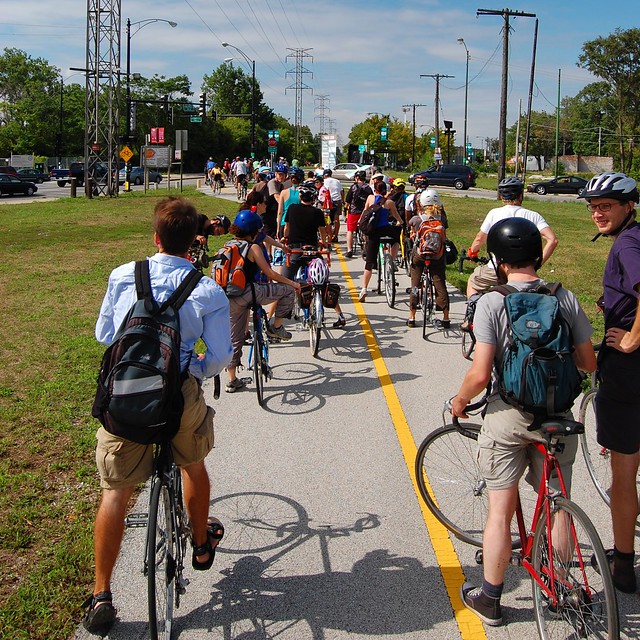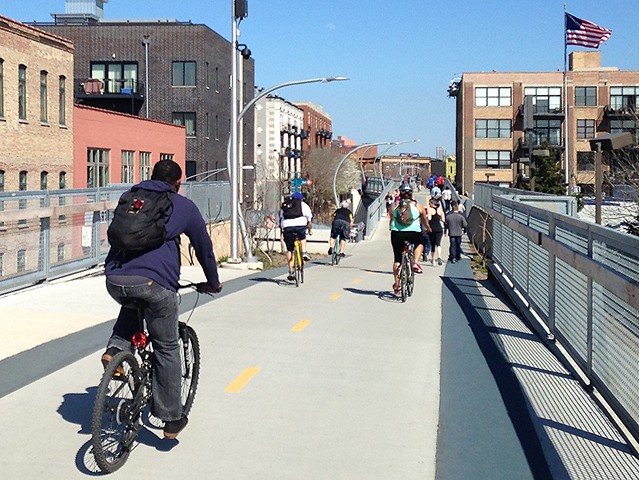The Chicago Tribune’s new transportation columnist Mary Wisniewski, a former Sun-Times transportation reporter, is off to a good start. She’s written a number of article that show an interest in promoting sustainable transportation, rather than the windshield perspective that has been all-to-common in the mainstream media.
For example, her articles about bicycling have asked *what* Chicago should be doing to encourage bike riding, rather than *whether* we should be promoting cycling at all. That’s a refreshing change from some of the Tribune’s previous misinformed, overly skeptical coverage of new bicycle infrastructure. And let’s not even get started on columnist John Kass’ irresponsible bike trolling.
This new approach is part of the general positive trend of Chicago’s mainstream media coming around to the idea that biking is good our city, as the Active Transportation Alliance recently noted in a blog post.
Wisniewski recently ran an interesting column looking at why the Bloomingdale Trail elevated greenway on the Northwest Side, which opened last June, is already so much better known and used than the nine-year-old Major Taylor Trail on the Southwest Side. That’s despite the fact that the Bloomingdale, also known as The 606, is only 2.7 miles while the Major Taylor is a full 6.5 miles.
According to members of Friends of the Major Taylor Trail, even some folks who live close to that trail seem unaware of its existence.
Wisniewski highlights several reasons why the Major Taylor gets less use. Broken glass is a problem. There are some challenging streets crossings that need improvement, such as those at Halsted Street and 111th Street. There’s a gap in the path between 105th Street and 95th Street, which forces riders to take a somewhat convoluted route on streets between the two segments.
Wisniewski notes that the Major Taylor runs though less densely populated neighborhoods than the Bloomingdale. She also points out that The 606 connects with Milwaukee Avenue, the city’s busiest biking route, nicknamed “The Hipster Highway.”

It’s a good article overall, but the author overlooked a few points. The Bloomingdale serves Wicker Park, Bucktown, Humboldt Park, and Logan Square, neighborhoods with some of the city's highest bike mode share. It’s a useful route for commuting downtown, and it also provides direct access to many neighborhood schools. Meanwhile, the Major Taylor runs southeast to northwest, so it’s not a convenient route for biking from the Southwest Side towards the Loop.
But the biggest edge The 606 has over the Major Taylor is that, since it's an elevated trail with no at-grade street crossings, users have zero chance of being struck by motorists. Sure, with the Bloomingdale’s high volume of pedestrians and cyclists during nice weather, using it sometimes requires caution and courtesy.
But it still offers an overall level of comfort that a standard trail can’t hold a candle to. That makes it the perfect place to walk or bike with young kids, or just enjoy a relaxing commute or cruise without having to look over your shoulder for cars.
A problematic aspect of Wisniewski’s piece is her rather alarmist depiction of personal security issues on the trail, which won’t encourage more people to try riding on it:
The trail's solitude adds to the feeling of insecurity: The southern end leading to the Little Calumet River is lovely but on a quiet weekday feels like Fangorn Forest in "The Lord of the Rings" — vaguely unsettling.
David Miller, 46, of Englewood, comes often to Whistler Woods after work to watch for a pair of bald eagles, but the burly truck driver will not go on the trail itself. "You don't know who's up in there," he said.
I'm anything but a burly guy, but in my dozens of rides on the Major Taylor, I’ve never encountered anything scarier than a flat tire. In fairness, Wisniewski notes that there have been only a handful of reported crimes on the trail within the last nine years.
However, violent crime has actually emerged as an issue on The 606. In February and March there were three incidents where cyclists were jumped and mugged on the Bloomingdale at night. As I’ve written, one strategy for addressing this problem would be to legalize 24/7 commuting on the path, which is already the situation on the Lakefront Trail. That way there would be more “eyes on the trail” to deter attacks.
Overall, however, the Tribune piece makes an important point. The Major Taylor Trail is an overlooked bike resource that the city, the Chicago Park District, and the Cook County Forest Preserve could make more useful and popular through better maintenance, intersection treatments, and promotion.
![]()
Did you appreciate this post? Streetsblog Chicago is currently funded until June 2016. Consider making a donation through our PublicGood site to help ensure we can continue to publish next year.





